Residential Building Construction Techniques and the Potential for Energy Efficiency in Central Asia: Example from High-Altitude Rural Settlement in Kyrgyzstan
Abstract
1. Introduction
1.1. Setting the Scene
1.2. The Gap in the Research
1.3. Research Questions, Objectives and Methodology
- What sort of building construction techniques are available in high-altitude rural Kyrgyzstan?
- What are the predominant building materials used to build high-altitude rural houses?
- What is the energy demand of the existing rural Kyrgyz houses and what is the potential for energy efficiency?
1.4. The Novelty of the Study
- Scientific information acquisition about residential building construction procedure.
- A detailed assessment of the old and new/current building construction techniques in combination with the various building construction materials.
- Theory and context of the rural Kyrgyz building sector including architectural plans, routine behaviour, cultural and traditional aspects.
- A novel and sequential roadmap for building energy efficiency was designed by considering local boundary conditions.
2. Theory and Context: The Kyrgyz Building Sector
3. Traditional Single-Family House in Rural Kyrgyzstan: An Outlook
4. The Kyrgyz Building Construction Techniques
4.1. Building Foundation
4.2. Floor
4.3. Walls
4.3.1. Clay/Adobe/Cob Walls
4.3.2. Rammed Earth
4.3.3. Clay Lumps
4.3.4. Wall Plaster
4.3.5. Vapour Barrier
4.4. Ceiling
4.5. Roof
4.6. Windows and Doors
5. Outlook and Discussion
5.1. Potential of Building Energy Efficiency in Rural Kyrgyzstan
5.2. Motivation for the Energy Efficiency Roadmap Devolvement
5.3. Base Case: Typical Rural Kyrgyz House
5.4. Case 1/Step 1: Replacing the Wooden Windows with Plastic-Based Windows
5.5. Case 2/Step 2: Ceiling Insulation with Locally Available Sustainable Insulation Material
5.6. Case 3/Step 3: Open Roof Closing
5.7. Case 4/Step 4: Wall Insulation with Locally Available Sustainable Insulation Material
6. Conclusions
- Experimental analysis of the building structure is highly advisable. Because most of the houses were built 40–50 years ago, it is difficult to gain accurate information about building structures (for example, the thickness and composition of the individual layers and materials of the building envelope).
- Because of the use of traditional heating devices, there are no detailed data available on heating setpoints or heating demand profiles. The household initializes the heating process when they feel cold inside the house. In that case, it is necessary to measure the inside air temperature for a more extended period to identify the level of thermal comfort and the heating setpoint, both of which have a significant impact on the simulation results.
- The energy efficiency only considers the existing houses right now. During the interview, it was identified that ground insulation is expensive, as it needs additional labour to carry out the ground insulation work. Therefore, the article only focuses on the building energy efficiency of the existing rural houses.
Author Contributions
Funding
Acknowledgments
Conflicts of Interest
References
- USAID. Climate Risk Profile: Central Asia: Fact Sheet; USAID: Washington, DC, USA, 2018.
- Batsaikhan, U.; Dabrowski, M. Central Asia—Twenty-five years after the breakup of the USSR. Russ. J. Econ. 2017, 3, 296–320. [Google Scholar] [CrossRef]
- Russell, M. Connectivity in Central Asia: Reconnecting the Silk Road. Available online: https://www.europarl.europa.eu/RegData/etudes/BRIE/2019/637891/EPRS_BRI(2019)637891_EN.pdf (accessed on 5 April 2020).
- Mehta, K.; Ehrenwirth, M.; Trinkl, C.; Zörner, W.; Greenough, R. The Energy Situation in Central Asia: A Comprehensive Energy Review Focusing on Rural Areas. Energies 2021, 14, 2805. [Google Scholar] [CrossRef]
- Swiss Development Cooperation. Sustainable Mountain Development. From Rio 1992 to 2012 and beyond. Central Asia Mountains: Regional Report; University of Central Asia and Zoï Environment Network: Bishkek, Kyrgyzstan, 2012. [Google Scholar]
- Fodde, E. Traditional Earthen Building Techniques in Central Asia. Int. J. Archit. Herit. 2009, 3, 145–168. [Google Scholar] [CrossRef]
- Giyasov, A.; Barotov, U.; Naimov, F. Clay buildings in modern energy efficient construction. E3S Web Conf. 2019, 91, 2023. [Google Scholar] [CrossRef]
- Satybayev, A.; Volordina, T.; Azhimatov, K.; Kalykov, A. Construction energy saving materials and their modern technology of work: In Russian. ИЗВЕСТИЯ ОШСКОГО ТЕХНОЛОГИЧЕСКОГО УНИВЕРСИТЕТА 2017, 3, 104–112. [Google Scholar]
- Botpaev, R.; Orozaliev, J.; Vajen, K. Economically optimal level of thermal insulation for single-family houses in Kyrgyzstan. In EuroSun2012; International Solar Energy Society: Rijeka, Croatia, 2012. [Google Scholar]
- Lorenzon, M.; Sadozai, C. From past to present: Building skill transfer in Tajikistan 2016. In Proceedings of the Terra Lyon 2016: Actes/Proceedings/Actos, Lyon, France, 10–14 July 2016. [Google Scholar]
- Muslimovich, A.S.; Ulugbek Arabdjon Ogli, A.; Raufjonovna, T.D. Fergana Valley Architectural School Decoration Methods. Am. J. Appl. Sci. 2020, 2, 21–25. [Google Scholar] [CrossRef]
- Osmonov, O.D.; Turdalieva, C. A History of Kyrgyzstan: From Stone Age to the Present: School and University Textbook; Sarybaev TT: Bishkek, Kyrgyzstan, 2015; ISBN 978-9967-04-680-1. [Google Scholar]
- Guillaud, H. An approach to the evolution of earthen building cultures in Orient and Mediterranean regions What future for such an exceptional legacy? Al-Rāfidān J. West. Asiat. Stud. 2003. Available online: https://hal.archives-ouvertes.fr/hal-01663127 (accessed on 20 November 2022).
- Tukhtamisheva, A.; Adilova, D.; Banionis, K.; Levinskytė, A.; Bliūdžius, R. Optimization of the Thermal Insulation Level of Residential Buildings in the Almaty Region of Kazakhstan. Energies 2020, 13, 4692. [Google Scholar] [CrossRef]
- Azizova, B. Architectural Longevity-in the Case of the Summer Palace Chandra-Hauly in Khiva City, Uzbekistan. MOJCE 2017, 2. [Google Scholar] [CrossRef][Green Version]
- IEA. Total Final Energy Consumption by Sectors in Central Asia. Available online: https://www.iea.org/data-and-statistics?country=TAJIKISTAN&fuel=Energy%20consumption&indicator=Total%20final%20consumption%20(TFC)%20by%20sector (accessed on 5 April 2020).
- Mehta, K.; Ehrenwirth, M.; Trinkl, C.; Zörner, W. Mapping Potential for Improving Rural Energy Services in Kyrgyzstan: Factors for Achieving Sustainable Development Goals in the Community Context. World 2022, 3, 586–606. [Google Scholar] [CrossRef]
- Bergström, S.; Johannessen, F. Sustainable Housing in Kyrgyzstan. Investigation of Two Multi-Apartment Buildings in Bishkek; Lund University: Lund, Sweden, 2014; Available online: http://www.ees.energy.lth.se/fileadmin/ees/Publikationer/Ex5297-Bergstrom_Johannessen.pdf (accessed on 18 February 2020).
- UNFCC. Hird National Communication of the Kyrgyz Republic under the UN Framework Convention on Climate Change. Available online: https://unfccc.int/sites/default/files/resource/NC3_Kyrgyzstan_English_24Jan2017.pdf. (accessed on 13 April 2021).
- Mehta, K.; Ehrenwirth, M.; Trinkl, C.; Zörner, W.; Greenough, R. Impact of Locally Available Thermal Insulation Structures on Space Heating Demand of High-altitude Rural Buildings: A Case Study of Kyrgyzstan. In Proceedings of the EuroSun 2020, Virtual, 1–3 September 2020. [Google Scholar]
- Mehta, K. Rural Energy Supply: A Case Study of Kyrgyzstan. Master’s Thesis, Technische Hochschule Ingolstadt, Ingolstadt, Germany, 2019. [Google Scholar]
- Schuler, M. Migration Patterns of the Population in Kyrgyzstan. Espace Popul. Soc. 2007, 1, 73–89. [Google Scholar] [CrossRef]
- United Nations. Country Profiles on the Housing Sector. Available online: https://unece.org/fileadmin/DAM/hlm/documents/Publications/cp.kyrgyzstan.e.pdf (accessed on 11 January 2021).
- Mehta, K.; Ehrenwirth, M.; Trinkl, C.; Zörner, W. Towards Sustainable Community Development through Renewable Energies in Kyrgyzstan: A Detailed Assessment and Outlook. World 2022, 3, 327–343. [Google Scholar] [CrossRef]
- Nguyen, A.T.; Truong, N.S.H.; Rockwood, D.; Tran Le, A.D. Studies on sustainable features of vernacular architecture in different regions across the world: A comprehensive synthesis and evaluation. Front. Archit. Res. 2019, 8, 535–548. [Google Scholar] [CrossRef]
- Mehta, K.; Ehrenwirth, M.; Missall, S.; Degembaeva, N.; Akmatov, K.; Zörner, W. Energy Profiling of a High-Altitude Kyrgyz Community: Challenges and Motivations to Preserve Floodplain Ecosystems Based on Household Survey. Sustainability 2021, 13, 13086. [Google Scholar] [CrossRef]
- Balabanyan, A. Keeping Warm: Urban Heating Options in the Kyrgyz Republic-Summary Report (English); The World Bank Group: Washington, DC, USA, 2015; Available online: http://documents1.worldbank.org/curated/en/555021468011161504/pdf/97409-WP-P133058-Box391503B-PUBLIC-Heating-Assessment-for-Kyrgyz-P133058-Final.pdf (accessed on 12 January 2021).
- Sagynbekova, L. Environment, Rural Livelihoods, and Labor Migration: A Case Study in Central Kyrgyzstan. Mt. Res. Dev. 2017, 37, 456. [Google Scholar] [CrossRef]
- FAO. National Gender Profile of Agricultural and Rural Livelihoods-Kyrgyz Republic: Country Gender Assessment Series; Food and Agriculture Organization of the United Nations: Ankara, Turkey, 2016; Available online: http://www.fao.org/3/a-i5763e.pdf (accessed on 20 August 2020).
- Paul, J. Analysis of Historic Rammed Earth Construction. Ph.D. Thesis, Durham University, Durham, UK, 2008. [Google Scholar]
- Gasparrini, A.; Guo, Y.; Hashizume, M.; Lavigne, E.; Zanobetti, A.; Schwartz, J.; Tobias, A.; Tong, S.; Rocklöv, J.; Forsberg, B.; et al. Mortality risk attributable to high and low ambient temperature: A multicountry observational study. Lancet 2015, 386, 369–375. [Google Scholar] [CrossRef] [PubMed]
- World Bank Group. Advancing Heating Services beyond the Last Mile: Central Asia Pilot Experience with High-Efficiency, Low-Emissions Heating Technologies: ESMAP Paper; World Bank Group: Washington, DC, USA, 2019; Available online: https://openknowledge.worldbank.org/handle/10986/31282 (accessed on 2 March 2021).
- Zeman, J. Improving Energy Efficiency in Buildings, Kyrgyz Republic: Final Evaluation: UNDP/GEF Medium Size Project; United Nations Development Programme: New York, NY, USA, 2014; Available online: https://erc.undp.org/evaluation/documents/download/7695 (accessed on 19 May 2021).
- Boronbaev, E. Energy saving Architecture: Background, Theory and Practice in Kyrgyzstan. E3S Web Conf. 2020, 172, 19010. [Google Scholar] [CrossRef]
- USAID. Kyrgyzstan Construction Materials Value Chain Stakeholder Analysis: Final Report; The International Business Council: Bishkek, Kyrgyzstan, 2015. [Google Scholar]
- NREL. EnergyPlus; U.S. Department of Energy: Washington, DC, USA, 2020.
- MEI. Microfinancing Household Insulation and Heating Measures in Kyrgyzstan: An Assessment Study by MicroEnergy International for Deutsche Gesellschaft für Internationale Zusammenarbeit GmbH.; GIZ: Berlin, Germany, 2013; Available online: https://eba.klink.asia/klink/ccf9ca/download (accessed on 25 January 2019).
- Mehta, K.; Mingaleva, E.; Zörner, W.; Degembaeva, N.; Baibagyshov, E. Comprehensive analysis of the energy legislative framework of Kyrgyzstan: Investigation to develop a roadmap of Kyrgyz renewable energy sector Clean. Energy Syst. 2022, 2, 10013. [Google Scholar] [CrossRef]
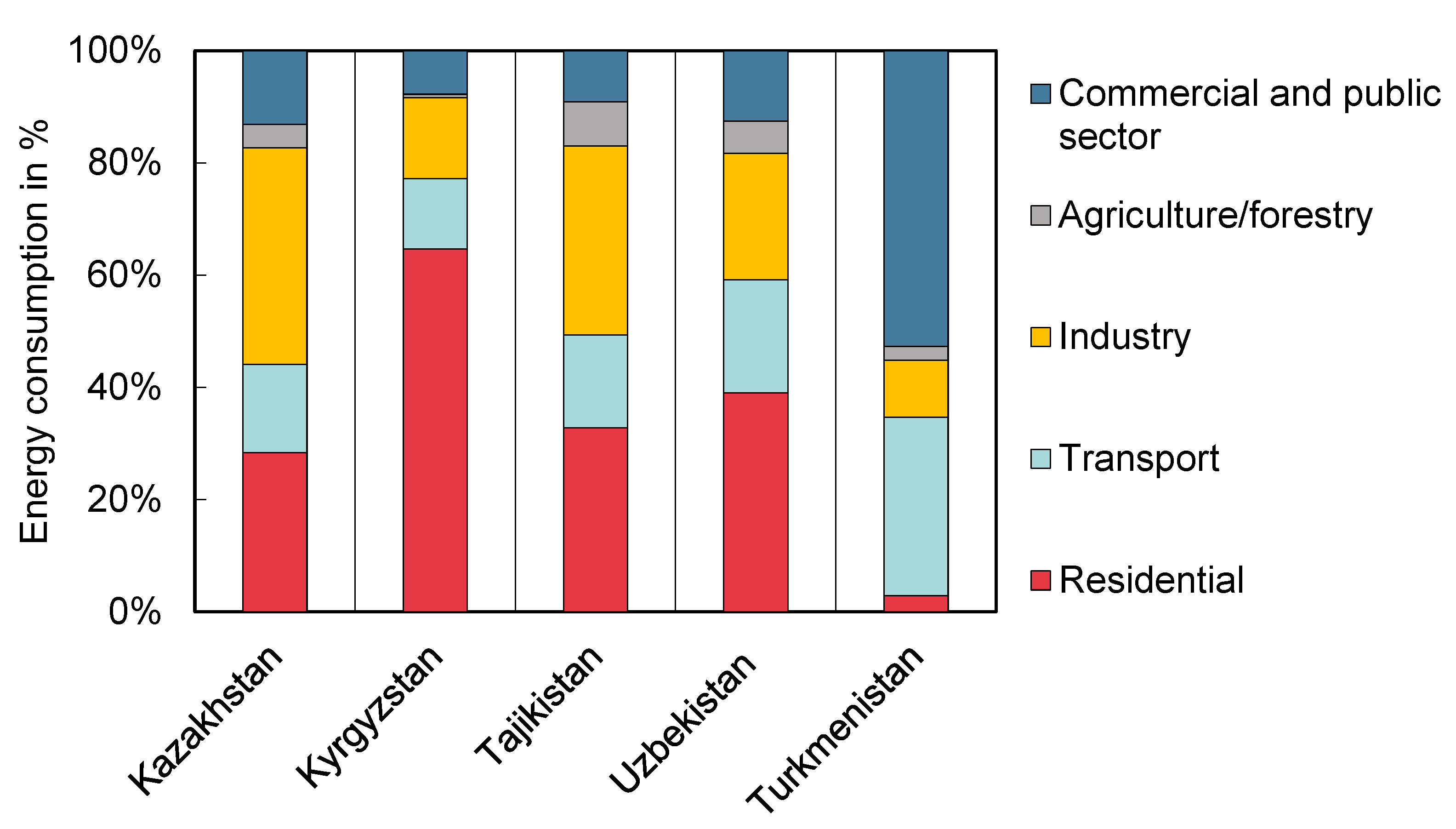
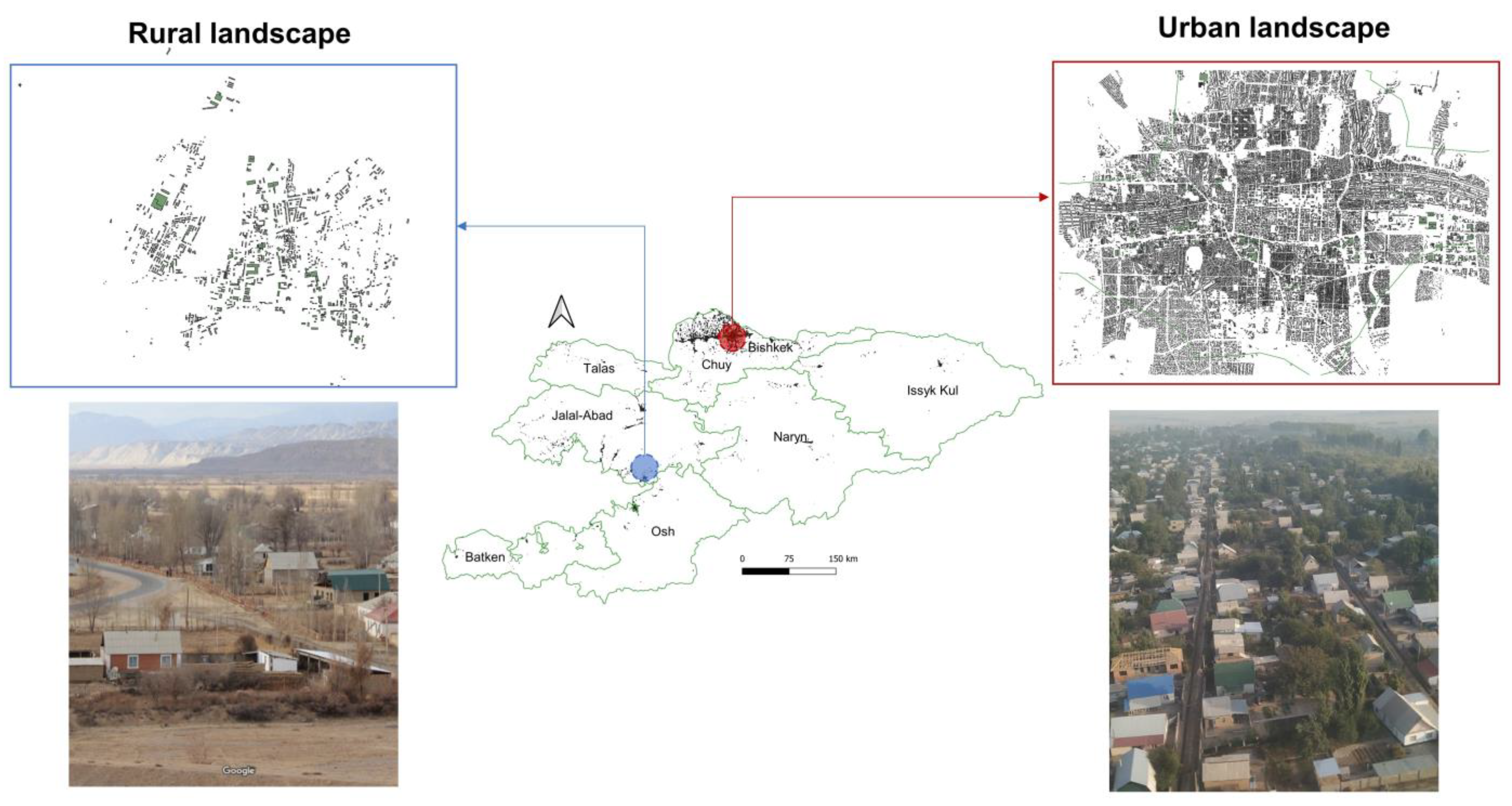
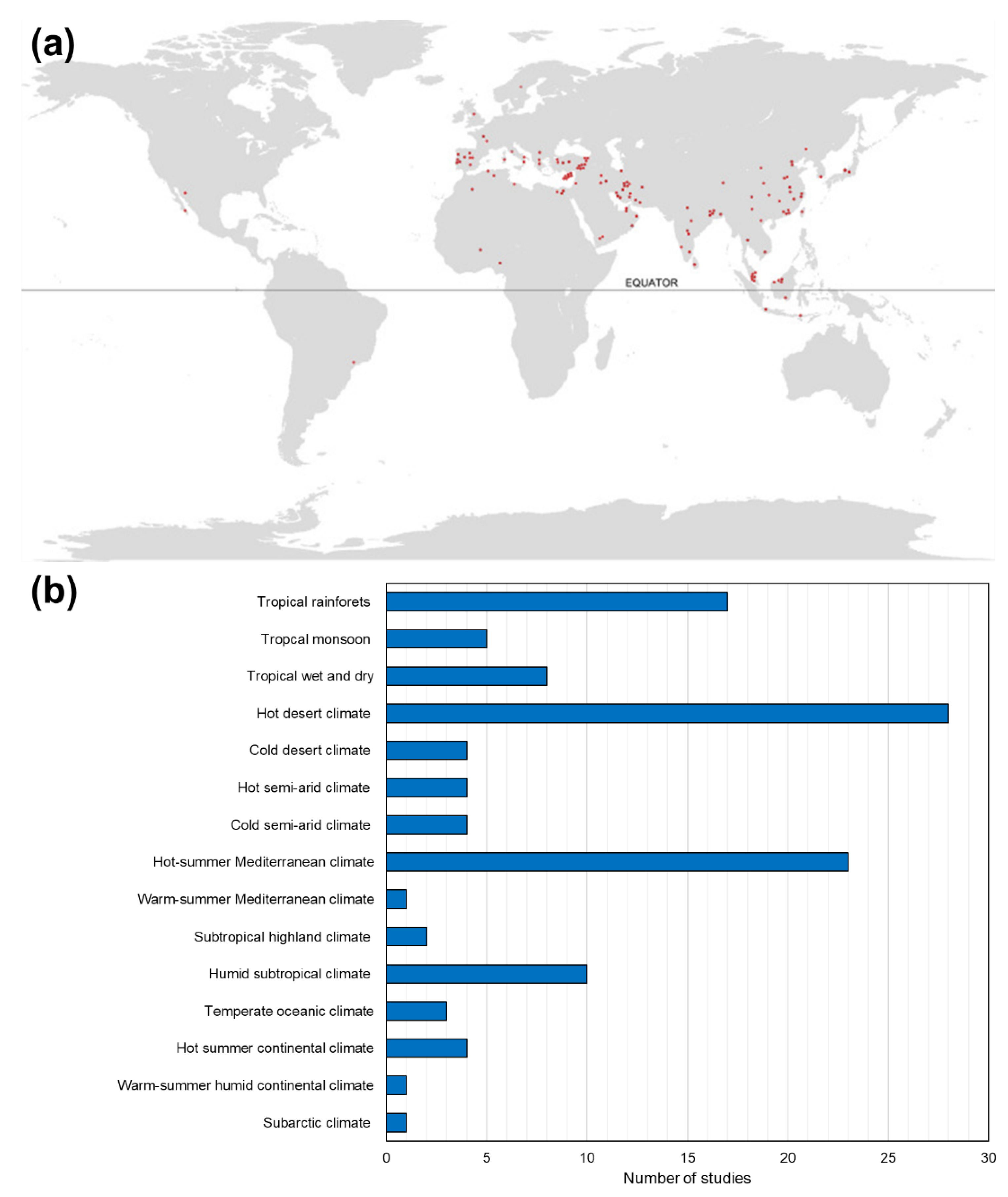
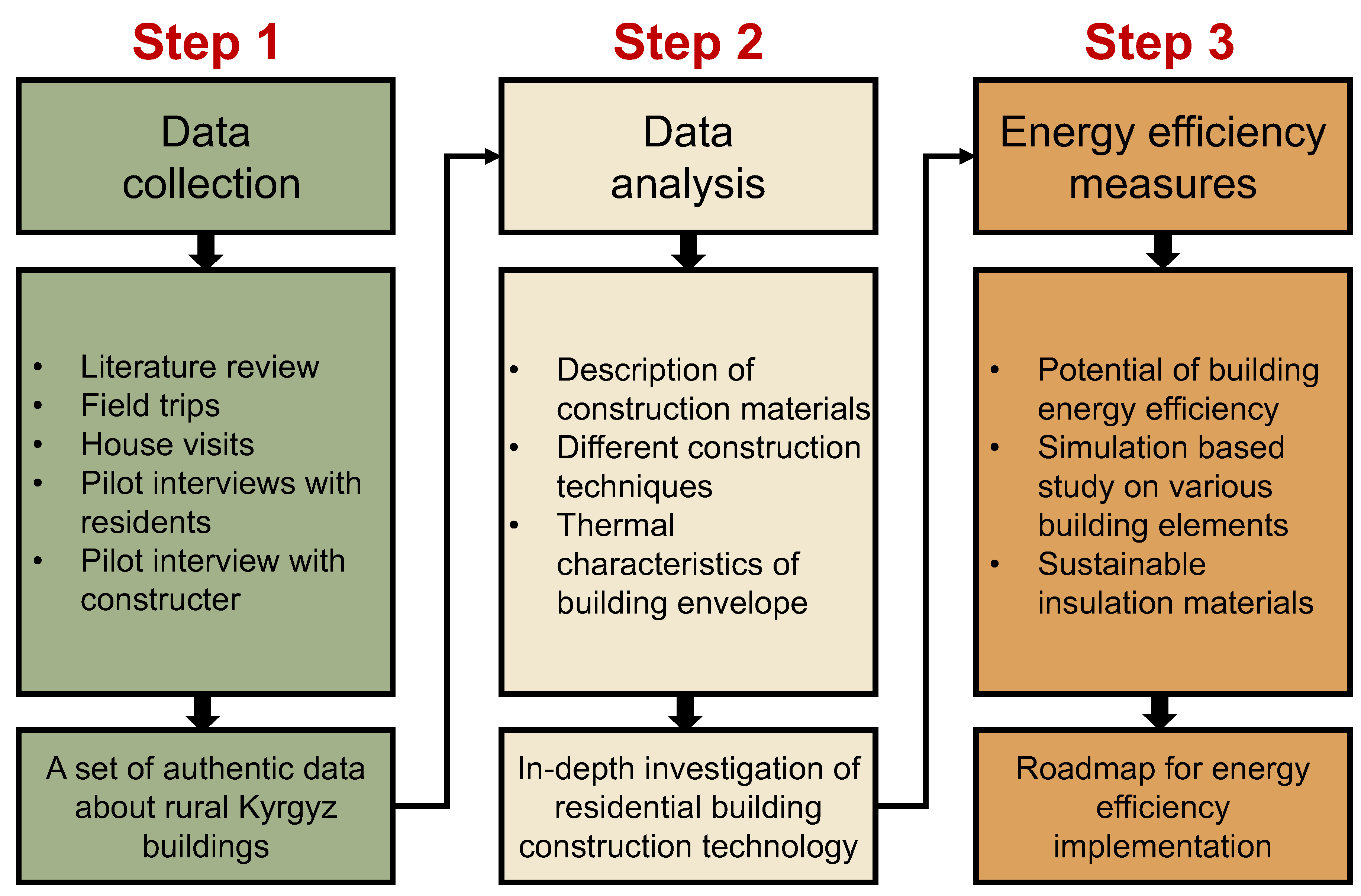
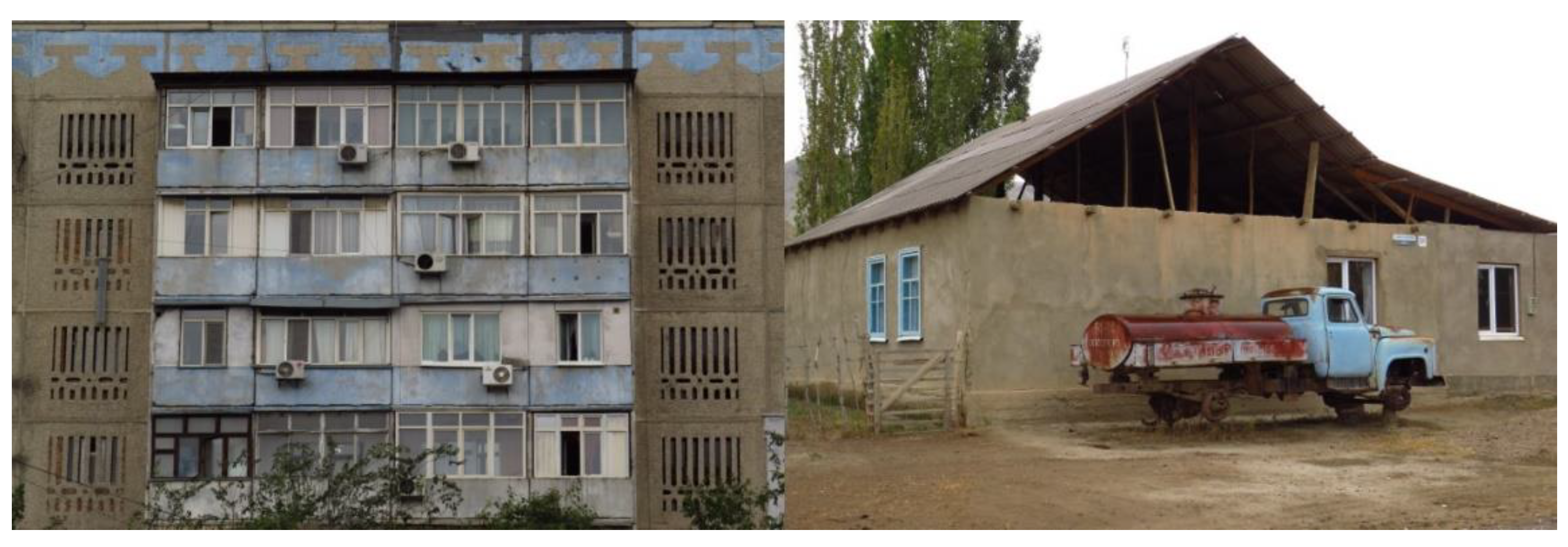
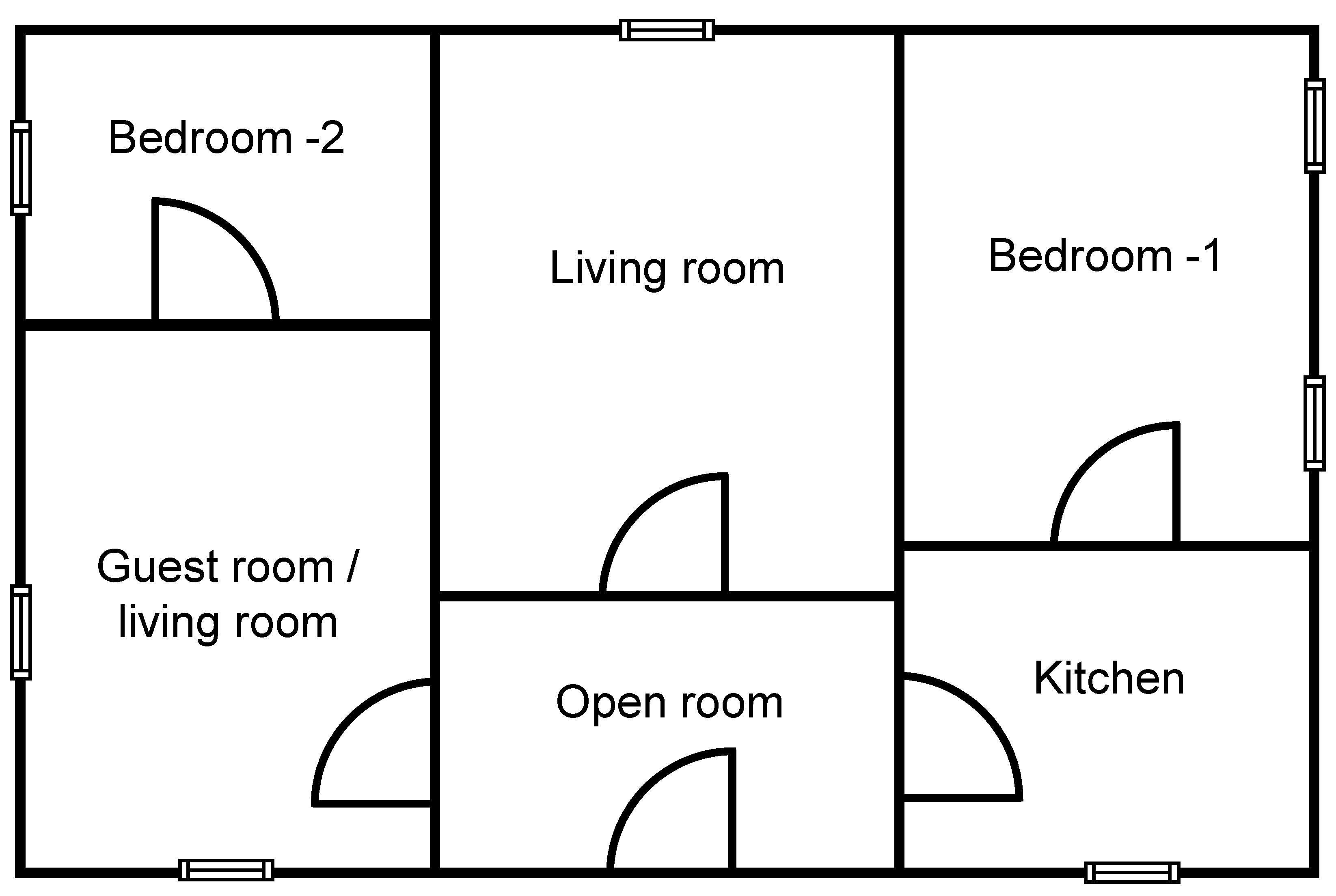



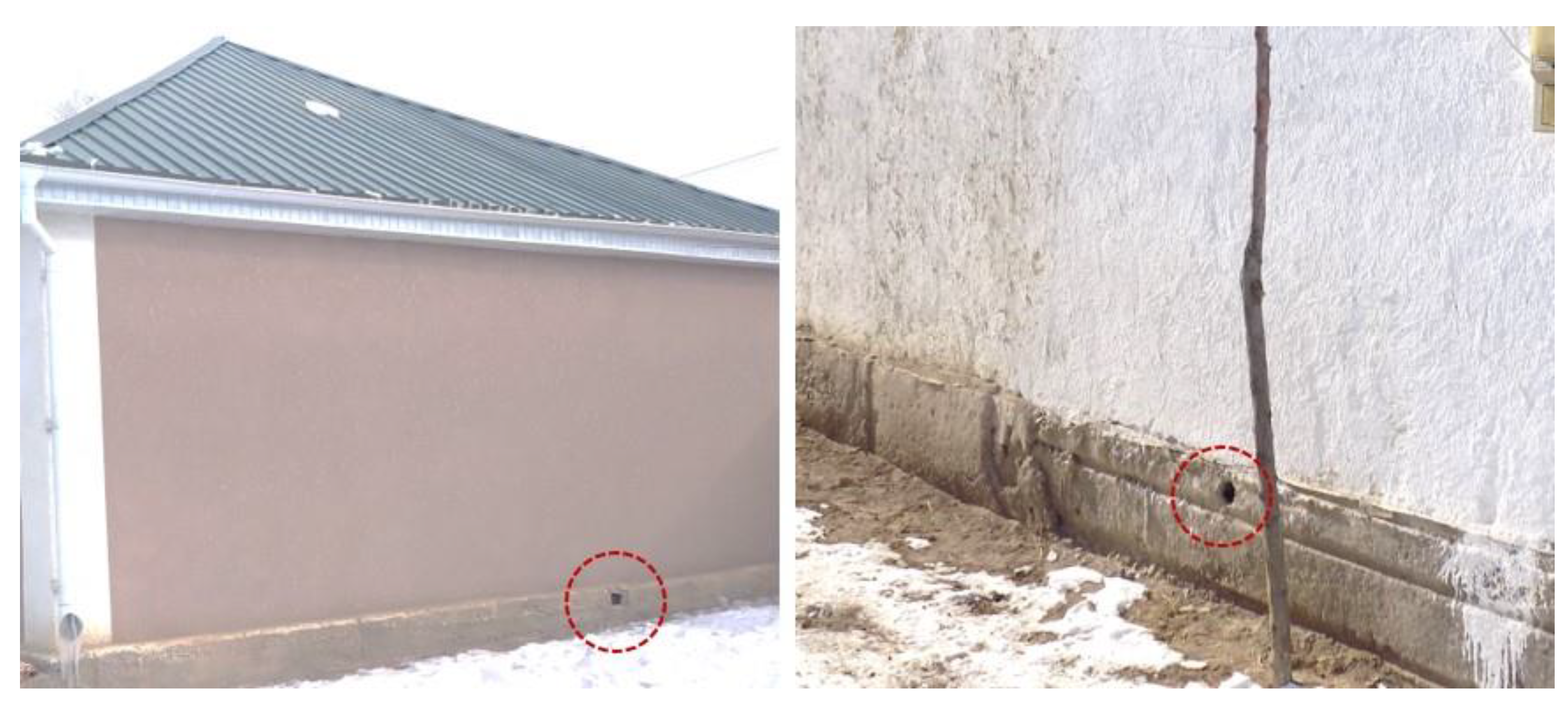
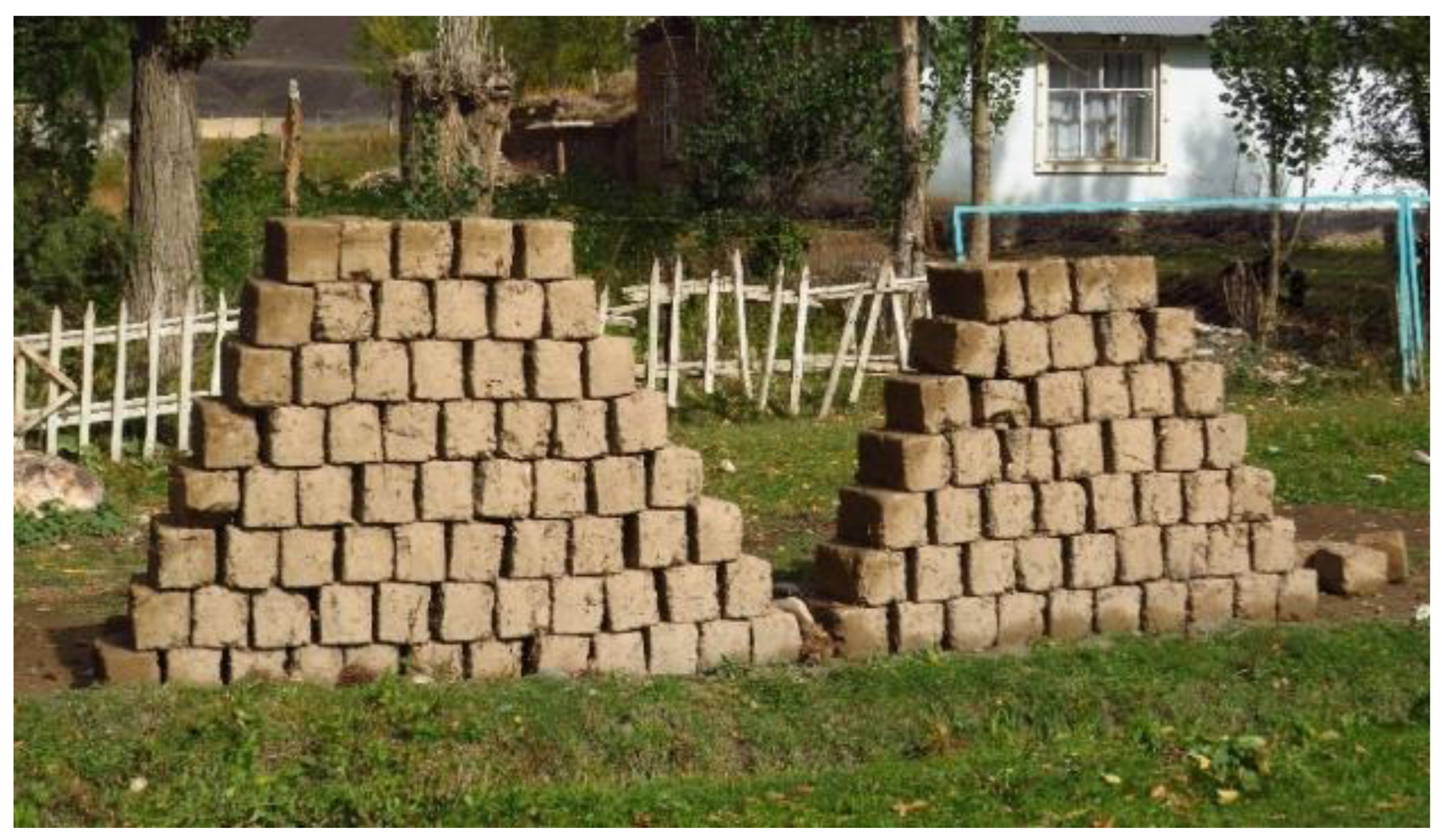







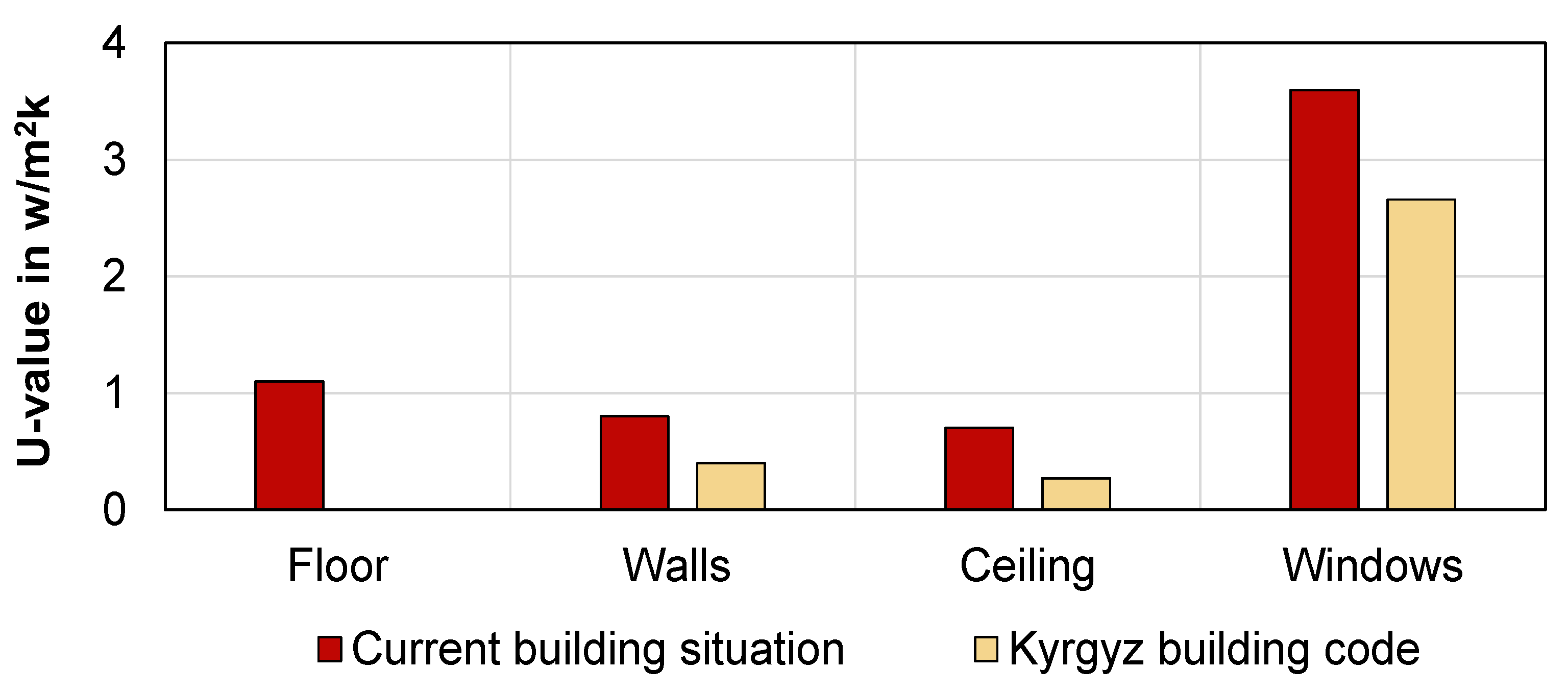
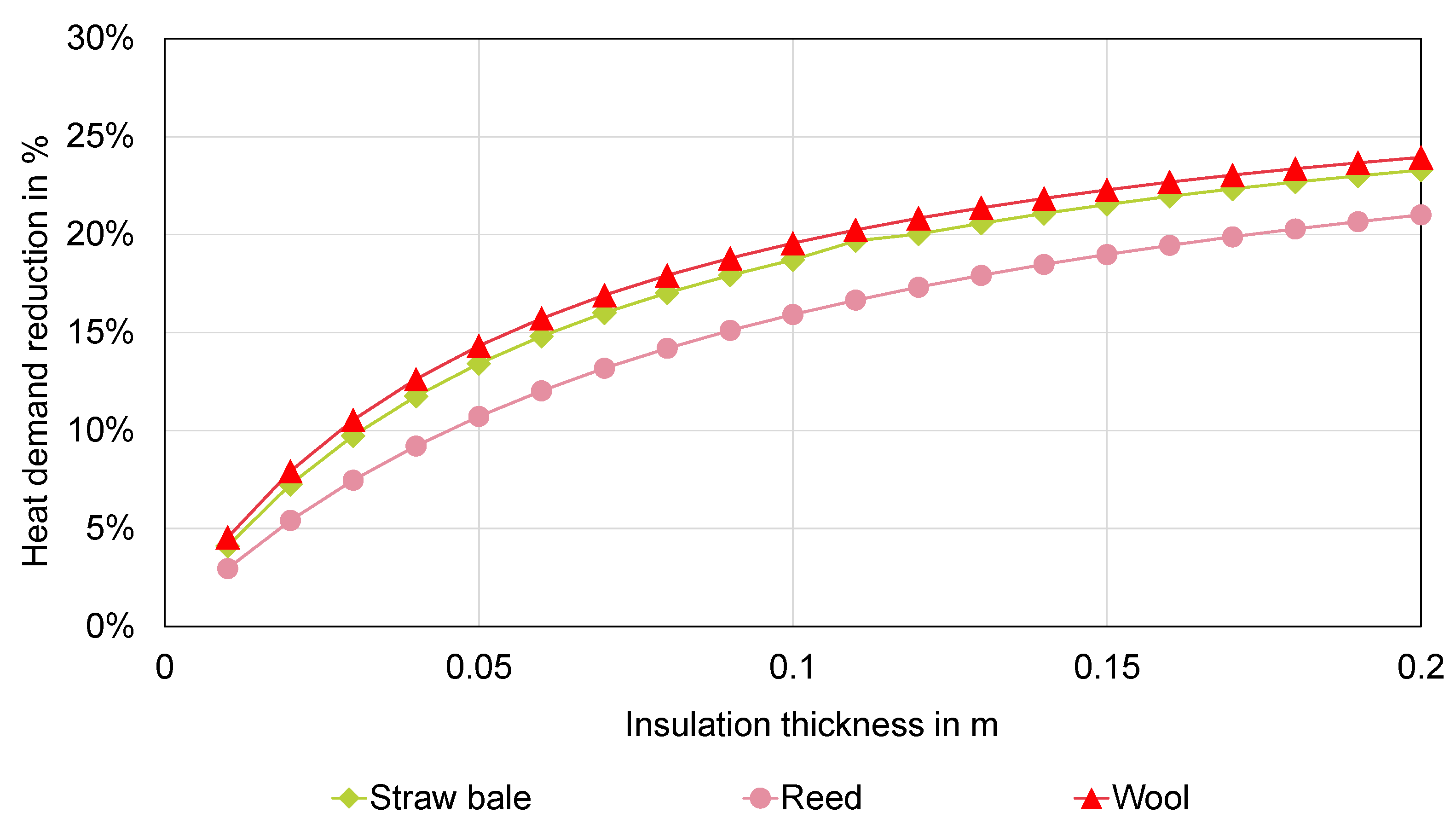
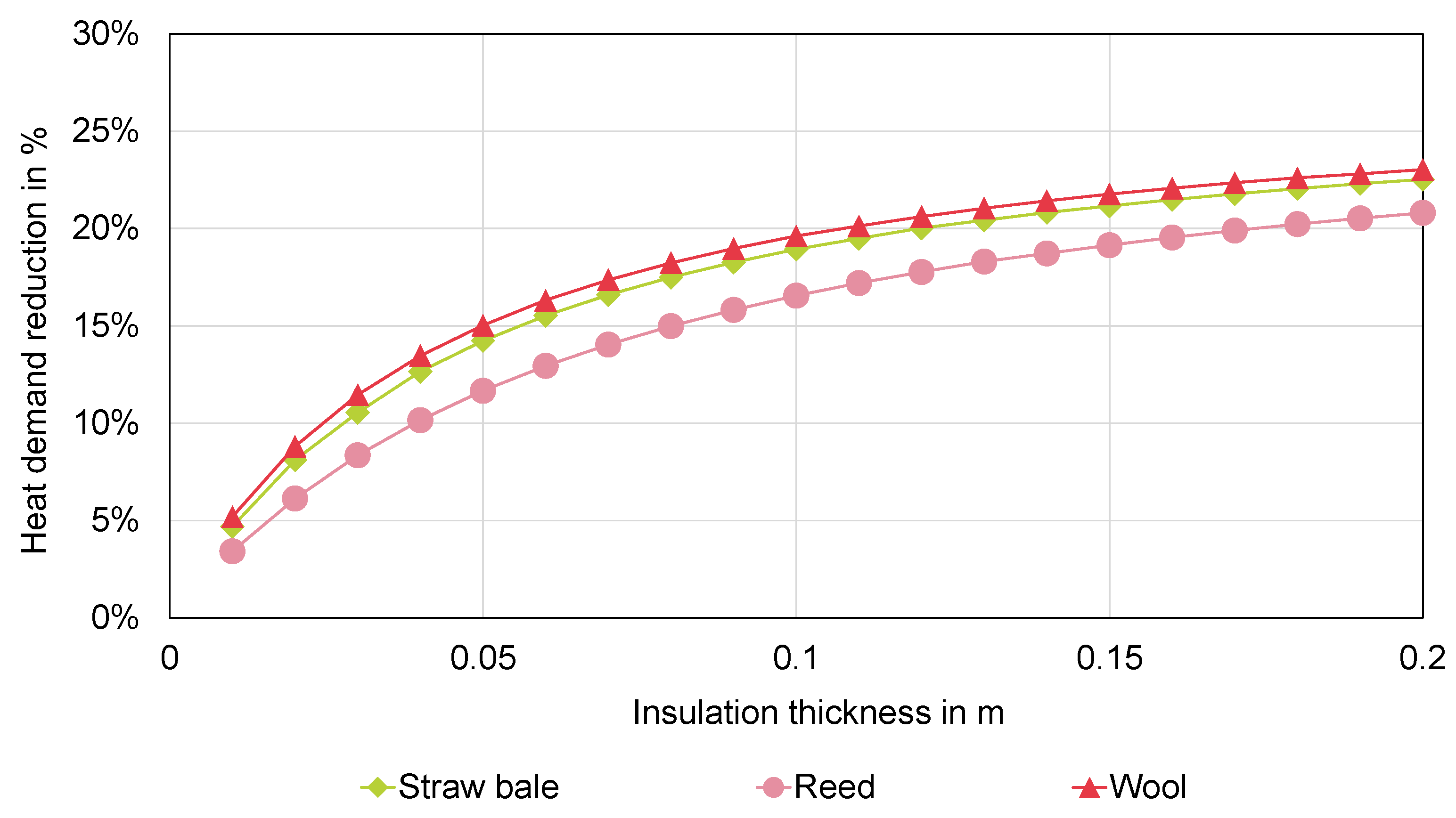

| Base Case | Typical Rural Kyrgyz House |
|---|---|
| Case 1 (step 1) | Replacing the wooden windows with plastic-based windows |
| Case 2 (step 2) | Ceiling insulation with locally available sustainable insulation material |
| Case 3 (step 3) | Open roof closing |
| Case 4 (step 4) | Wall insulation with locally available sustainable insulation material |
Publisher’s Note: MDPI stays neutral with regard to jurisdictional claims in published maps and institutional affiliations. |
© 2022 by the authors. Licensee MDPI, Basel, Switzerland. This article is an open access article distributed under the terms and conditions of the Creative Commons Attribution (CC BY) license (https://creativecommons.org/licenses/by/4.0/).
Share and Cite
Mehta, K.; Zörner, W.; Greenough, R. Residential Building Construction Techniques and the Potential for Energy Efficiency in Central Asia: Example from High-Altitude Rural Settlement in Kyrgyzstan. Energies 2022, 15, 8869. https://doi.org/10.3390/en15238869
Mehta K, Zörner W, Greenough R. Residential Building Construction Techniques and the Potential for Energy Efficiency in Central Asia: Example from High-Altitude Rural Settlement in Kyrgyzstan. Energies. 2022; 15(23):8869. https://doi.org/10.3390/en15238869
Chicago/Turabian StyleMehta, Kedar, Wilfried Zörner, and Rick Greenough. 2022. "Residential Building Construction Techniques and the Potential for Energy Efficiency in Central Asia: Example from High-Altitude Rural Settlement in Kyrgyzstan" Energies 15, no. 23: 8869. https://doi.org/10.3390/en15238869
APA StyleMehta, K., Zörner, W., & Greenough, R. (2022). Residential Building Construction Techniques and the Potential for Energy Efficiency in Central Asia: Example from High-Altitude Rural Settlement in Kyrgyzstan. Energies, 15(23), 8869. https://doi.org/10.3390/en15238869








